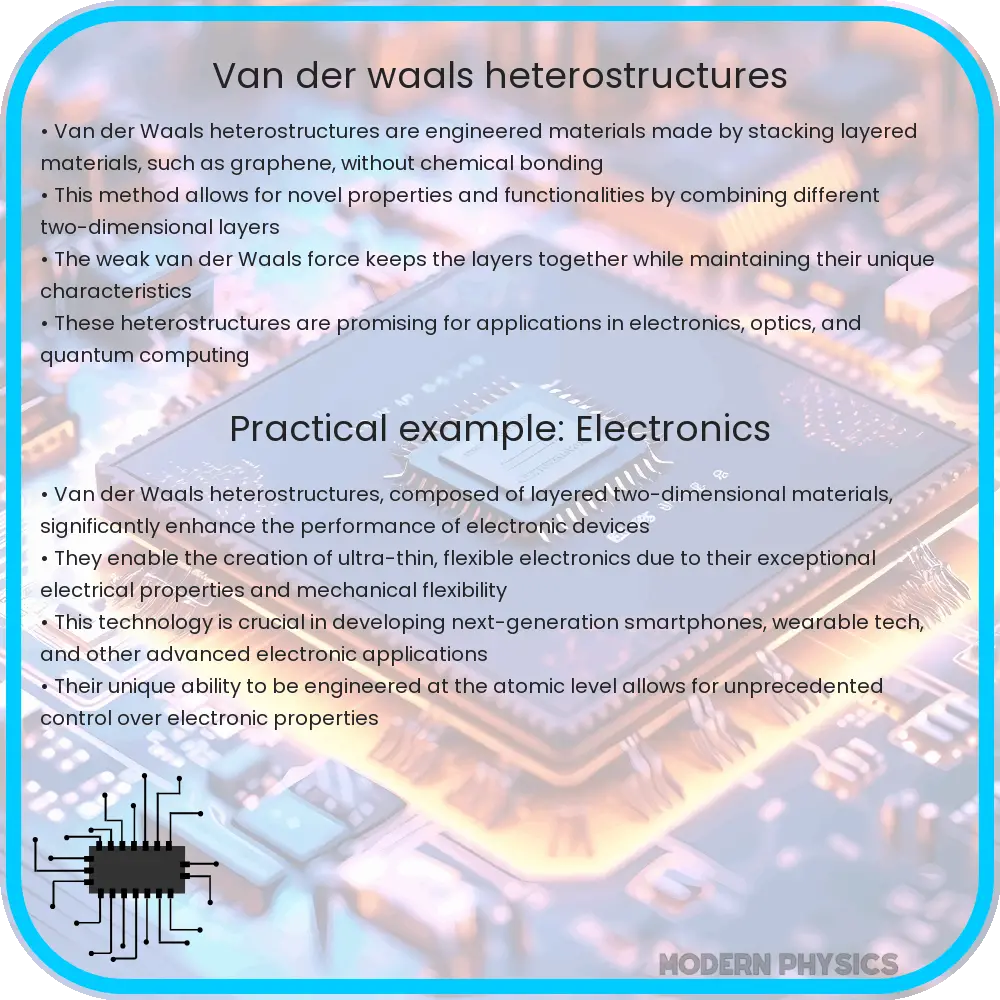Explore the revolution of Van der Waals heterostructures in material science, their advancements, vast applications, and the theoretical insights driving innovation.

Exploring Van der Waals Heterostructures: A Leap Forward in Material Science
The realm of material science has been revolutionized with the advent of Van der Waals (vdW) heterostructures, promising a new era of electronic and optoelectronic devices. These heterostructures are unique assemblies of two-dimensional (2D) materials, stacked one on top of another without the need for lattice matching, thanks to the vdW forces. This breakthrough has opened up unprecedented possibilities in the fabrication and performance of nanoscale devices.
Advancements in Van der Waals Heterostructures
Recent advancements in vdW heterostructures have been remarkable, focusing on the manipulation of their electronic, optical, and mechanical properties. Scientists have successfully integrated various 2D materials, such as graphene, hexagonal boron nitride (h-BN), and transition metal dichalcogenides (TMDCs) like MoS2, WS2, and WSe2, to create heterostructures with tailored properties. These structures exhibit exceptional charge carrier mobility, mechanical strength, and flexibility. Moreover, the ability to engineer the band structure of these heterostructures has led to the realization of devices with enhanced performance, such as high-speed transistors, sensitive photodetectors, and efficient solar cells.
Applications Beyond Electronics
While the electronic and optoelectronic applications of vdW heterostructures are vast, their potential extends into other innovative areas. For instance, in the field of sensing, these heterostructures have demonstrated unparalleled sensitivity and selectivity, making them ideal for environmental monitoring, healthcare diagnostics, and biochemical detection. Additionally, their unique properties are being harnessed in energy storage and conversion technologies, including batteries and supercapacitors, paving the way for more efficient and compact energy solutions.
Theoretical Underpinnings
At the heart of vdW heterostructures lies a rich theoretical framework that guides their design and optimization. The theory revolves around the understanding of vdW forces at the quantum level, which facilitates the precise stacking of 2D materials without direct chemical bonding. This aspect is crucial for maintaining the intrinsic properties of each layer while achieving new functionalities through their combination. Computational models and simulations play a pivotal role in predicting the properties of these heterostructures, enabling researchers to explore a vast landscape of material combinations before physical experimentation.
The exploration of vdW heterostructures is a testament to the dynamic nature of material science, showcasing how fundamental theoretical insights can lead to technological innovations. As research in this field progresses, the potential applications of these heterostructures are only expected to expand, marking a new chapter in the development of advanced materials.
Challenges and Future Directions
Despite the significant progress in the development of Van der Waals heterostructures, challenges remain. Fabrication techniques require further refinement to ensure uniformity and scalability for commercial applications. The precise control over the alignment and orientation of the stacked layers is critical for optimizing the performance of the heterostructures. Moreover, the stability of these materials under operational conditions needs to be enhanced to extend their lifespan and reliability in practical applications.
Future research is poised to address these challenges, with a focus on developing innovative synthesis methods that can produce large-scale, high-quality vdW heterostructures. Advances in characterization techniques will also provide deeper insights into the interlayer interactions and their effects on the properties of the heterostructures. Additionally, exploring new combinations of 2D materials will further expand the functional capabilities of vdW heterostructures, opening up new avenues for application in quantum computing, flexible electronics, and beyond.
Conclusion
Van der Waals heterostructures stand at the forefront of material science, offering a versatile platform for the creation of next-generation devices with unparalleled performance. The synergy between theoretical understanding and experimental innovation has propelled this field forward, leading to significant advancements and a broad spectrum of applications. While challenges in fabrication and stability present hurdles to their widespread adoption, ongoing research and development are paving the way for overcoming these obstacles. The future of vdW heterostructures is bright, promising a transformative impact on technology and society. As we continue to unravel the complexities of these materials, their full potential is yet to be realized, heralding a new era of material science that is limited only by our imagination.
